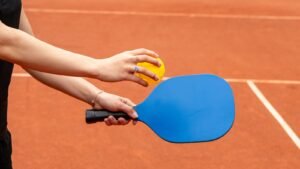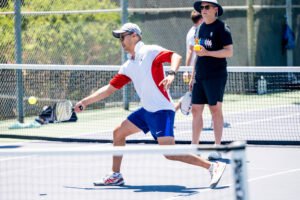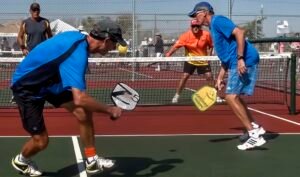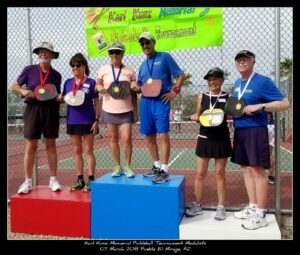In the exhilarating world of competitive pickleball, where strategic shots and lightning-fast reflexes rule the court, one often neglects a crucial aspect of the game: rest and recovery. Amidst the flurry of intense gameplay and adrenaline surges, it is easy to underestimate the importance of taking a step back, allowing our bodies and minds to replenish. Yet, in this captivating sport that demands relentless agility, stamina, and tactful maneuvering, understanding the significance of rest becomes essential in order to maximize our performance and achieve our true potential on the pickleball court. So, let us delve into the realms of restful rejuvenation, exploring the depths of its significance and unraveling the secrets it holds for triumphant victories in the realm of competitive pickleball.
Table of Contents
- The Essential Role of Rest in Maximizing Competitive Pickleball Performance
- Understanding the Science behind Recovery for Optimal Pickleball Gameplay
- Strategies for Effective Rest and Recovery in Pickleball Training
- Key Recommendations for Balancing Rest and Active Recovery in Competitive Pickleball
- Exploring the Psychological Benefits of Rest and Recovery for Peak Pickleball Performance
- Q&A
- In Retrospect
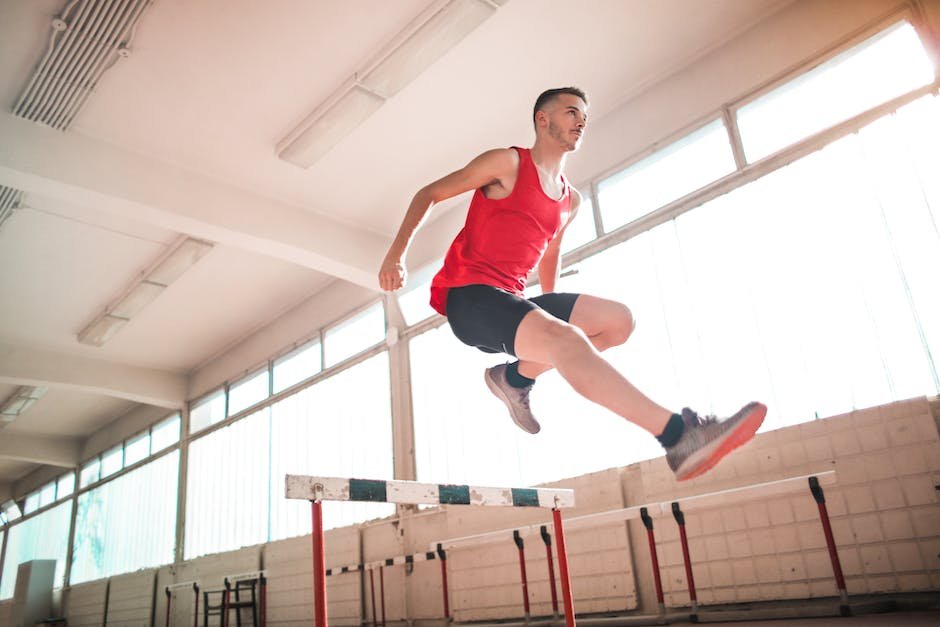
The Essential Role of Rest in Maximizing Competitive Pickleball Performance
Rest is an often overlooked aspect of competitive pickleball performance, yet its importance cannot be overstated. In the fast-paced world of pickleball, where every second counts, taking time to rest and recover may seem counterintuitive. However, rest is essential for optimizing your performance and preventing exhaustion and burnout.
One of the key benefits of rest is its ability to enhance muscle recovery. When we participate in vigorous pickleball matches or intense training sessions, our muscles undergo stress and micro-tears. Without proper rest, these microscopic injuries can accumulate, leading to decreased performance and increased risk of injury. Allowing your muscles time to repair and rebuild through rest and sleep is crucial for maintaining strength and agility on the pickleball court.
Additionally, rest plays a vital role in mental rejuvenation. Competitive pickleball requires strategic thinking, quick decision-making, and precise execution. Engaging in continuous play without adequate rest can lead to mental fatigue and impaired cognitive function. Taking breaks between matches or training sessions allows your brain to recharge, enhancing focus and concentration when it matters most.
- Rest aids in preventing injuries and promoting longevity in your pickleball career.
- Recovery time enables the body to replenish energy stores, improving overall endurance.
- Quality sleep during rest periods enhances learning and skill consolidation.
In conclusion, rest is a fundamental component of maximizing competitive pickleball performance. Don’t underestimate the power of a well-deserved break. Prioritize rest, both physical and mental, to give yourself the best chance of reaching your full potential on the pickleball court.

Understanding the Science behind Recovery for Optimal Pickleball Gameplay
Playing pickleball requires quick reflexes, agility, and endurance. To maintain a high level of performance on the court, it is crucial to understand the science behind recovery. Proper recovery techniques can help maximize your gameplay and prevent injuries.
1. Rest and Sleep: Adequate rest and sleep are vital for muscle recovery and growth. Aim for 7-9 hours of quality sleep each night to allow your body to repair itself and replenish energy levels. Incorporate rest days into your pickleball training routine to avoid overexertion.
2. Nutrition: A well-balanced diet plays a significant role in the recovery process. Ensure you consume enough protein to support muscle repair and carbohydrates to replenish glycogen stores. Hydration is also essential for optimal performance. Drink plenty of water before, during, and after playing pickleball to replace lost fluids.
3. Stretching and Mobility: Incorporate stretching exercises into your warm-up and cool-down routines to improve flexibility and prevent muscle imbalances. Dynamic stretching, such as leg swings and arm circles, can help activate and prepare your muscles for gameplay. Additionally, foam rolling or using a massage ball can aid in muscle recovery and reduce post-exercise soreness.
4. Active Recovery: Engage in light physical activities, such as brisk walking or swimming, on your off days. These low-intensity exercises promote blood flow, reduce muscle soreness, and enhance overall recovery. Don’t underestimate the power of gentle movement in enhancing your gameplay.
By understanding the science behind recovery and implementing these techniques into your routine, you can optimize your performance on the pickleball court and enjoy the sport to the fullest. Remember, a well-rested and properly recovered body is the foundation for optimal gameplay and long-term success.
Strategies for Effective Rest and Recovery in Pickleball Training
Rest and recovery are essential components of any successful pickleball training routine. Incorporating proper strategies can help prevent injuries, improve performance, and enhance overall well-being. Here are some effective techniques to optimize your rest and recovery:
- Listen to your body: Pay attention to your body’s signals and give yourself the rest you need. If you feel fatigued or experience muscle soreness, take a day or two off from training.
- Implement active recovery: Engage in activities that promote blood circulation and decrease muscle stiffness, such as light stretching, yoga, or a leisurely walk. These low-intensity exercises help flush out lactic acid and promote healing.
- Practice quality sleep: Adequate sleep plays a crucial role in restoration and rejuvenation. Aim for 7-9 hours of uninterrupted sleep each night to optimize your recovery capabilities.
- Nutrition matters: Fuel your body with nutrient-rich foods to aid in the recovery process. Ensure you consume a balanced diet consisting of lean proteins, whole grains, fruits, and vegetables. Proper hydration is also key, as it helps flush out toxins and supports muscle repair.
- Consider cross-training: Engaging in activities other than pickleball can give specific muscle groups a break while still maintaining overall fitness. Try low-impact exercises like swimming or cycling to reduce strain on your joints.
By prioritizing rest and recovery in your pickleball training routine, you’ll not only improve your on-court performance but also prolong your playing career. Remember, recovery is just as important as training to achieve long-term success in this exhilarating sport.
Key Recommendations for Balancing Rest and Active Recovery in Competitive Pickleball
When it comes to competitive pickleball, finding the right balance between rest and active recovery is crucial for maintaining performance and preventing injuries. Here are some key recommendations to help you strike that delicate equilibrium:
- Vary your training intensity: It’s important to mix up your training routine by alternating between intense practice sessions and lighter ones. This variation allows your body to recover and adapt, reducing the risk of overuse injuries while still improving your skills.
- Implement active recovery exercises: Incorporating specific active recovery exercises into your routine can enhance the recovery process. These exercises, such as light jogging or cycling, help to increase blood flow and promote muscle repair.
- Listen to your body: Paying attention to the signals your body sends is critical for ensuring proper rest and recovery. If you’re feeling excessively fatigued or experiencing persistent muscle soreness, it might be a sign that you need additional rest to prevent burnout.
- Include rest days: Building rest days into your training schedule is vital for allowing your body to recharge and repair. Aim for at least one or two days of complete rest each week, where you can focus on activities unrelated to pickleball or any intense physical exertion.
- Get sufficient sleep: Quality sleep is integral to the recovery process. Aim for a consistent sleep schedule, ensuring you get the recommended 7-9 hours of uninterrupted sleep each night. This will aid in muscle repair, mental rejuvenation, and overall performance.
By following these recommendations, you’ll be able to optimize your rest and active recovery routine, leading to improved performance, reduced fatigue, and a greater longevity in your competitive pickleball journey.
Exploring the Psychological Benefits of Rest and Recovery for Peak Pickleball Performance
Rest and recovery play a pivotal role in achieving optimal performance in any athletic endeavor, and pickleball is no exception. While physical rejuvenation is often the focus, the significance of psychological well-being cannot be overlooked. In fact, the mind-body connection is a powerful entity that can greatly influence an athlete’s performance on the pickleball court.
Embracing rest and recovery not only allows the body to repair and rebuild, but it also nurtures mental resilience and fosters a positive mindset. Here are three psychological benefits of incorporating ample rest and recovery into your pickleball training regime:
- Mental Clarity: Rest provides the brain with an opportunity to recharge and reset. When well-rested, players can approach the game with heightened focus, sharp decision-making, and improved concentration. Clarity of thought becomes a valuable asset during high-pressure situations, giving players a competitive edge.
- Stress Reduction: Rest and recovery serve as powerful stress relievers. By taking time to relax and rejuvenate, players can reduce anxiety levels, improve mood, and create a sense of balance in their lives. This stable emotional state directly impacts performance, enabling players to stay calm under pressure and make sound judgment calls during intense pickleball matches.
- Inspiration and Motivation: Adequate rest enhances creativity and rejuvenates passion for the game. It allows players to step back from the court, reflect on their performance, and gain fresh perspectives. During this time, new strategies and techniques may emerge, reigniting the fire within and motivating players to push their boundaries further.
Remember, embracing rest and recovery is not a sign of weakness, but rather a strategy for achieving peak pickleball performance. Incorporating these practices into your training routine will not only benefit your physical well-being but also improve your psychological resilience, helping you reach new heights on the pickleball court.
Q&A
Why is rest and recovery important in competitive pickleball?
Rest and recovery are crucial in competitive pickleball to allow the body to repair and rebuild itself. It helps to prevent injuries, improve overall performance, and maintain mental focus during intense matches.
How does rest benefit a pickleball player?
Rest plays a vital role in reducing the risk of overuse injuries and fatigue. It allows muscles, tendons, and joints to recover and adapt, leading to increased strength and endurance, ensuring players can perform at their best.
What are the physical benefits of recovery?
Recovery helps reduce muscle soreness, inflammation, and risk of overtraining. It allows the body’s energy stores to replenish, promoting better overall physical health and preventing burnout in the long run.
Can rest and recovery enhance mental performance?
Absolutely! Rest and recovery help players maintain mental clarity and focus, which are essential for making quick decisions and strategizing during intense pickleball matches. It also aids in reducing stress and improving overall mental well-being.
How often should pickleball players incorporate rest days?
Pickleball players should aim to incorporate rest days into their training schedule at least once or twice a week. However, the frequency may vary depending on the intensity of their training and individual recovery needs.
Are there any specific recovery techniques recommended for pickleball players?
Yes, several recovery techniques can benefit pickleball players, including adequate hydration, proper nutrition, stretching, foam rolling, and getting enough quality sleep. Active recovery exercises like light stretching or low-impact activities can also aid in reducing muscle stiffness and aiding in recovery.
Can improper recovery lead to performance decline?
Yes, improper recovery can lead to performance decline due to increased risk of injuries, decreased strength and endurance, and reduced mental focus. It’s essential to prioritize rest and recovery to maintain peak performance levels and prevent setbacks.
Is there any role of rest and recovery in injury prevention?
Definitely! Rest and recovery give the body enough time to repair and rebuild itself, reducing the risk of overuse injuries. It allows for the correction of imbalances, proper tissue healing, and the rebuilding of strength, creating a more resilient and injury-resistant athlete.
How can pickleball players incorporate rest and recovery into their routine?
Pickleball players can incorporate rest and recovery into their routine by scheduling rest days, practicing proper sleep hygiene, prioritizing nutrition, and integrating active recovery exercises. It’s crucial to listen to their bodies and adjust training intensity and volume accordingly.
In Retrospect
As we lace up our shoes and gather around the court one last time, it’s crucial to remember that rest and recovery play an instrumental role in our journey through the dynamic world of competitive pickleball. We’ve paddled through exhilarating matches, pushed our limits, and chased our dreams relentlessly, but the final key lies in those cherished moments of rest. Just as the moon takes its restful pause before dazzling us with its luminescent radiance, our bodies, too, crave the solace of rejuvenation.
While the competitive spirit may tempt us to press on, diligently honing our skills day after day, we must resist the enticing call of burnout. Picture yourself as a bowstring, ready to propel that pickleball with precision and grace. Without proper rest, that once-taut string loses its elasticity, its power diminishes, and its aim falter. Our bodies and minds too, require tender care and nurturing, just as a brilliant artist needs time to contemplate and breathe life into their masterpiece.
Rest stands as the silent guardian of peak performance. It nurtures our muscles, allowing them to repair and strengthen, restoring harmony between agility and endurance. It reignites our creativity, offering a sanctuary for fresh ideas and strategies to weave their way into the game. Sleep, the magical potion that sparks vitality, invigorates our reflexes and intuition, granting us the agility of a gazelle and the instinct of a predator.
Yet, rest encompasses more than surrendering to sleep’s tender embrace. It is a symphony of elements merging in perfect harmony, embracing stillness, and embracing self. It beckons us to indulge in gentle stretching, soothing baths, and moments of mindfulness that provide solace amidst the whirlwind of competition. These acts of self-care breathe life into our souls, molding us into athletes who cherish every stroke, every dive, and every victory.
As we navigate the tantalizing world of competitive pickleball, let us not forget to embark on an odyssey of restoration. It is in the tender embrace of rest and recovery that champions are born. So, fellow pickleball enthusiasts, take heed! Pause, ponder, and partake in the rejuvenation that awaits you. Embrace rest’s enigmatic powers and discover the blissful synergy between the art of stillness and the ferocious beauty of the game. Remember, in the realm of fierce competition, rest remains our faithful ally, propelling us towards our greatest triumphs.
As an affiliate, my content may feature links to products I personally use and recommend. By taking action, like subscribing or making a purchase, you’ll be supporting my work and fueling my taco cravings at the same time. Win-win, right?
Want to read more? Check out our Affiliate Disclosure page.

